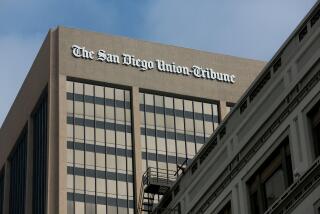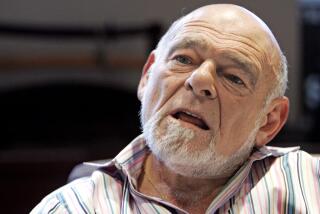Zell could be biggest winner
- Share via
Sam Zell’s taking effective control of Tribune Co. for a relatively modest cash outlay makes him potentially the biggest winner in Monday’s pending sale of the Chicago media company.
The Chicago real estate magnate would be in charge of a company valued Monday at $7.9 billion for an investment of as little as $315 million. That sum would give him an option to buy 40% of Tribune’s stock that could be exercised at any time within 15 years of the completion of the deal.
But financial analysts said Zell was unlikely to exercise the option but instead would probably cash it out before its expiration. In the meantime, as chairman, Zell would be calling the shots.
Whether Tribune’s employees win depends on whether the company’s performance continues to deteriorate as the newspaper and TV industries struggle. All company contributions to employee pension plans would be funneled through a new employee stock ownership plan, or ESOP, beginning next year, after the deal is complete.
That means that although those future pension contributions will be at risk, the employees stand to profit, along with Zell, if the company does well. Existing pension obligations owed to workers would not be affected, company executives said.
Also benefiting would be the Chandler family, which through its Times Mirror Co. controlled the Los Angeles Times for more than a century until the company was sold to Tribune in 2000. The pending buyout would serve the family’s desire to exit the newspaper business, while salvaging a fortune that had been eroding as Tribune’s stock slid.
The Chandlers’ 20% holding of Tribune would be bought out for a total of roughly $1.6 billion. But the payout probably would saddle the Chandlers with as much as $245 million in federal capital gains taxes.
Also getting a payout would be Tribune’s top five executives, who at the $34 price hold shares valued at $51.1 million along with millions more in stock options.
Among the early losers in the process would be the holders of Tribune’s existing $5 billion in bonds and other long-term debt. The value of their holdings already has plummeted as details of Tribune’s big debt load emerge.
The various steps of the multistage transaction require the company to obtain $8.4 billion in new debt, which could carry interest charges of at least 9% because Tribune is rated at junk bond, or below investment grade, level.
That means interest charges will be at least $756 million a year. Credit analysts say that’s troubling, because the company’s core businesses -- newspapers and broadcasting -- are suffering from declining revenues.
Credit reporting firm Fitch Ratings downgraded Tribune’s outstanding debt because the new borrowing would strain the company at a time when “its revenue and cash flow have been declining.”
When the deal is complete, Fitch analyst Mike Simonton said, Tribune’s debt could reach more than nine times its equity, leaving the company with “a very limited margin of error to withstand an economic downturn.”
Tribune Chairman and Chief Executive Dennis J. FitzSimons said Monday that he was confident the company’s annual cash flow, currently about $1.3 billion, would remain adequate to cover its debt obligation.
The transactions announced Monday would create hundreds of millions of dollars in tax benefits for the company -- possibly eliminating its tax liability entirely. Its effective federal and state tax rate for 2006 was 34.5%, resulting in $348 million in taxes on $1 billion in operating income.
The key aspect of the deal is the conversion of Tribune into a Subchapter S corporation. Such entities pay no corporate income tax but must funnel all profit directly to shareholders, who then pay taxes on those distributions. In this case, the sole shareholder would be the ESOP, which is itself untaxed. The combination of benefits may mean that the recapitalized Tribune would be essentially tax-exempt, a boon to a company with a need to harvest every dollar of revenue.
Tax regulations, however, sharply discourage any spinoff of assets by an S corporation within 10 years of its conversion from a conventional corporate structure. That’s because the gain in value of assets sold before the 10-year deadline is subject to tax (excluding whatever value was accumulated after the conversion). That would create an incentive for Zell to keep the company together for at least a decade, unless tax losses accumulated by Tribune are enough to shelter the tax generated by a spinoff. After the 10-year period, that tax liability disappears.
In the first step, Zell would invest $250 million in Tribune. Of this, $50 million would purchase 1.5 million shares of newly issued stock at $34 a share, and $200 million would essentially be a loan convertible into shares at the same price.
Simultaneously, the newly minted ESOP would invest $250 million lent by the company to buy stock at $28 a share. The lower price of its shares may have been designed to forestall any challenge to the deal based on its fairness to the employee plan.
The company would then buy 126 million shares, or about half of those outstanding, for $34 each, or a total of $4.28 billion. The tender offer would be financed by the $250-million infusion from Zell and from new corporate borrowings. That phase is expected to be completed by June 30.
In the second stage of the deal, expected to conclude at the end of 2007, Zell would invest an additional $65 million, bringing his total outlay to $315 million. At that point, his investment would comprise a $225-million, 11-year loan to the company and the $90-million purchase of a warrant giving him ownership of 40% of the company’s stock.
FitzSimons responded to criticism that the transaction would yield more control to Zell than warranted, noting that “this process was about maximizing shareholder value. We and the directors felt that relative to all the alternatives, this was the best value for the shareholders.”
He also acknowledged that Zell’s strategic vision for Tribune and his view of the community role of newspapers and television stations were not primary considerations in the weeks of negotiations leading to the deal. Tribune directors, FitzSimons said, instead were focused on “the financial terms of the agreement.”
Times staff writer Thomas S. Mulligan in New York contributed to this report.
*
(BEGIN TEXT OF INFOBOX)
Cashing in at the top
A look at the value of stock and options for top Tribune executives based on a Tribune sale at $34 a share:
Executives: Dennis FitzSimons, Chairman, CEO and president
Stock Shares: 672,965.38
Value (in millions): $22.9
2006 options: 300,000
Value: $852,000
--
Executives: Scott Smith, President, Tribune Publishing
Stock Shares: 295,146.52
Value (in millions): $10.0
2006 options: 90,000
Value: $255,600
--
Executives: Donald Grenesko, Senior v.p., finance and administration
Stock Shares: 312,708.84
Value (in millions): $10.6
2006 options: 85,000
Value: $241,400
--
Executives: John Reardon, President, Tribune Broadcasting
Stock Shares: 116,898.00
Value (in millions): $4.0
2006 options: 60,000
Value: $170,400
--
Executives: Crane Kenney, Senior v.p., general counsel and secretary
Stock Shares: 104,962.33
Value (in millions): $3.6
2006 options: 60,000
Value: $170,400
--
*2006 option grants priced at $31.16. Other options may also be exercisable.
--
Sources: SEC filings, Chicago Tribune
Los Angeles Times
More to Read
The biggest entertainment stories
Get our big stories about Hollywood, film, television, music, arts, culture and more right in your inbox as soon as they publish.
You may occasionally receive promotional content from the Los Angeles Times.










